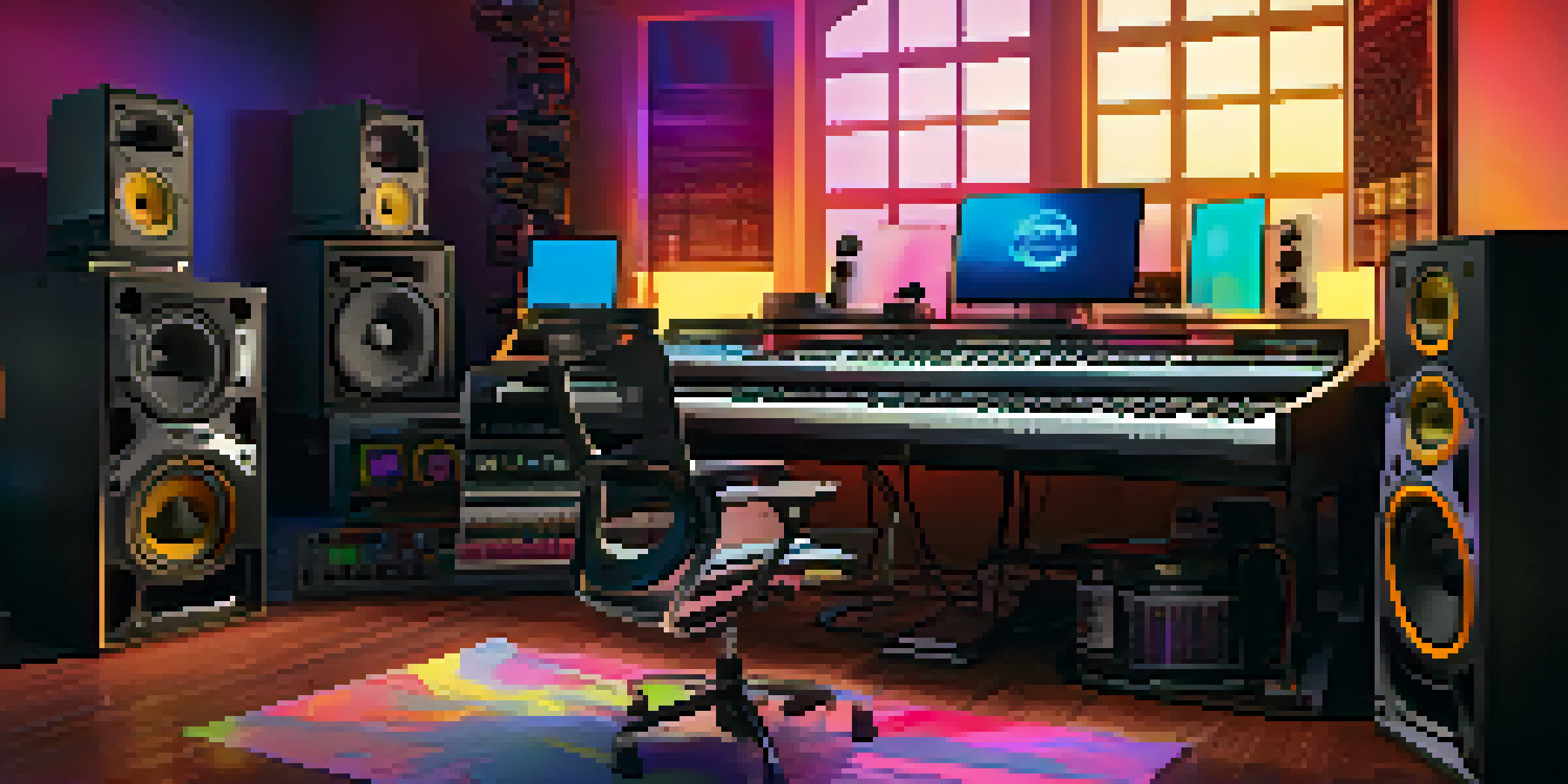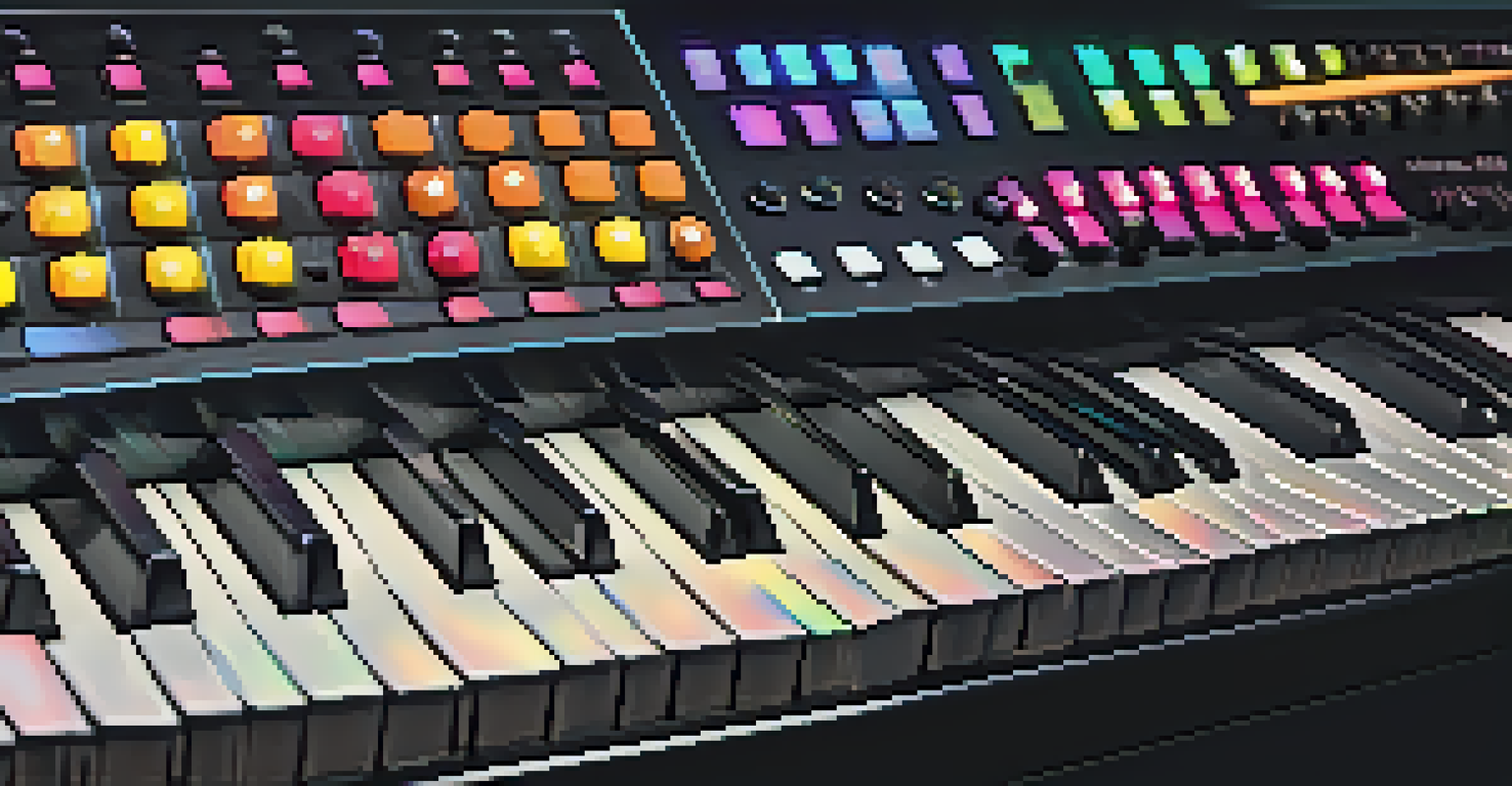The Evolution of Music Technology: Sound Waves and Innovation

Understanding Sound Waves: The Foundation of Music Technology
At the heart of music technology lies the concept of sound waves. These waves are vibrations that travel through air, water, or solid materials, creating the sounds we love. When a musician strums a guitar or taps a piano key, they generate sound waves that resonate in the environment, allowing us to hear music.
Music is the shorthand of emotion.
Sound waves can be classified into various types, such as longitudinal and transverse waves. Longitudinal waves, like those produced by a speaker, compress and rarefy the air, while transverse waves, like those seen on a stringed instrument, move perpendicular to the direction of the wave. Understanding these fundamentals is crucial for anyone interested in music technology.
As technology evolved, so did our ability to manipulate sound waves. From analog recordings to digital sound manipulation, each advancement has paved the way for new music creation techniques. This journey through sound waves is a testament to human creativity and innovation.
The Birth of Recording Technology: Innovations in Sound Capture
The invention of recording technology in the late 19th century marked a significant milestone in music's evolution. Early devices like Thomas Edison's phonograph allowed sound to be captured and played back, changing how we experienced music. For the first time, people could enjoy performances without needing to be present at the concert.

As recording methods progressed, so did the quality of sound reproduction. From wax cylinders to vinyl records, each format brought improvements, enhancing the listening experience. The introduction of magnetic tape in the mid-20th century revolutionized recording by allowing multiple tracks and editing, opening a world of creative possibilities.
Sound Waves: Music's Core Element
Understanding sound waves is essential for exploring music technology and how different instruments create unique auditory experiences.
Today, digital recording has taken the lead, enabling musicians to produce high-quality music with just a computer and software. This democratization of music production has led to an explosion of creativity, allowing anyone with a passion for music to share their sound with the world.
The Rise of Electronic Instruments: A New Era of Sound
The 20th century saw the emergence of electronic instruments, which transformed the music landscape. Instruments like the theremin and synthesizer introduced new sounds that were previously unimaginable. These innovations allowed musicians to explore uncharted territories of creativity, leading to the birth of new genres such as electronic and techno music.
The music is not in the notes, but in the silence between.
Synthesizers, in particular, became a game-changer in the 1970s and 1980s. They enabled artists to create complex soundscapes and manipulate sound in real time, all while being compact and relatively affordable. Iconic albums from this era showcased the potential of electronic music, influencing countless artists and genres.
Today, electronic instruments continue to evolve, integrating with digital technology to produce even more innovative sounds. With the rise of software synthesizers and MIDI controllers, musicians can now create and manipulate vast sound palettes, pushing the boundaries of music creation.
Digital Audio Workstations: Revolutionizing Music Production
Digital Audio Workstations (DAWs) have transformed how music is produced and recorded. These powerful software tools allow musicians to record, edit, and mix audio tracks with unparalleled flexibility. Whether you're a seasoned professional or a budding musician, DAWs provide an accessible way to create high-quality music from your home.
With features like virtual instruments, effects, and automation, DAWs empower artists to experiment and refine their sound. The barrier to entry has lowered significantly, as aspiring musicians can access a wealth of resources online. This shift has fostered a vibrant community of creators, sharing their work and collaborating across the globe.
Impact of Streaming on Music Access
Streaming services have transformed music consumption and distribution, enabling independent artists to reach global audiences but also presenting new challenges.
Popular DAWs like Ableton Live, Logic Pro, and FL Studio have become essential tools for modern musicians. As technology continues to advance, we can expect even more innovative features that will enhance the creative process and redefine what it means to produce music.
The Impact of Streaming Services on Music Consumption
The rise of streaming services has significantly changed how we consume music. Platforms like Spotify, Apple Music, and YouTube have made it easier than ever to access millions of songs at our fingertips. This shift has not only transformed listener habits but has also impacted how artists distribute their music.
Streaming has democratized music access, allowing independent artists to reach global audiences without the need for traditional record labels. However, this accessibility comes with challenges, such as lower revenue for artists and the need for effective marketing strategies. Musicians must adapt to the new landscape to thrive in this competitive environment.
Despite these challenges, streaming services have opened doors for innovative marketing strategies, such as curated playlists and social media engagement. Artists can now connect directly with their fans, building communities around their music in ways that were previously unimaginable.
The Role of AI in Shaping Future Music Technology
Artificial Intelligence (AI) is making waves in the music industry, revolutionizing how music is created and consumed. From AI-generated compositions to sophisticated recommendation algorithms, technology is reshaping the landscape. Musicians can now leverage AI tools to enhance their creative processes, generating ideas and experimenting with sounds.
AI can analyze vast amounts of data, helping artists understand trends and listener preferences. This information can guide their creative decisions, ensuring their music resonates with audiences. Additionally, AI-powered tools can assist in the mixing and mastering processes, making high-quality production more accessible.
AI's Role in Music Innovation
Artificial Intelligence is reshaping the music industry by assisting in creativity and production, while also providing valuable insights into listener preferences.
While some may worry about AI replacing human creativity, it can be seen as a collaborator rather than a competitor. By embracing AI's potential, musicians can push boundaries and explore new artistic directions, heralding a new era of music innovation.
The Future of Music Technology: Trends and Possibilities
As we look toward the future, music technology promises to continue evolving at a rapid pace. Emerging technologies like virtual reality (VR) and augmented reality (AR) offer exciting possibilities for immersive music experiences. Imagine attending a concert in your living room or collaborating with musicians from around the world in a virtual space.
Furthermore, advancements in sound engineering and spatial audio are set to redefine how we experience music. These technologies create a more dynamic sound environment, allowing listeners to feel as if they are in the middle of the performance. This shift could change not just how we listen but how we create music as well.

Ultimately, the future of music technology is bright and filled with potential. As innovation continues to drive the industry forward, we can expect new tools and concepts that will inspire the next generation of musicians and listeners alike.